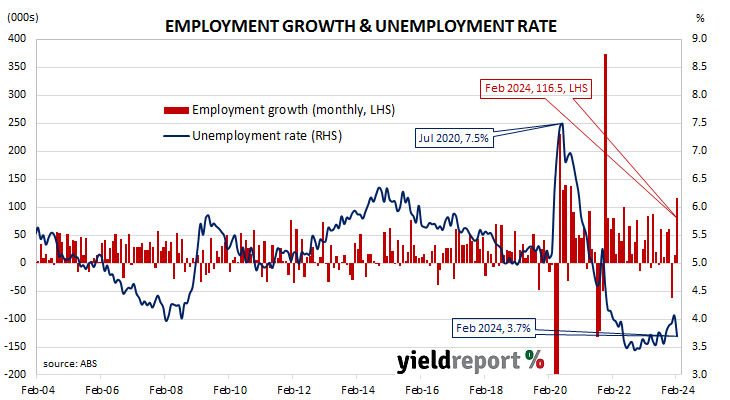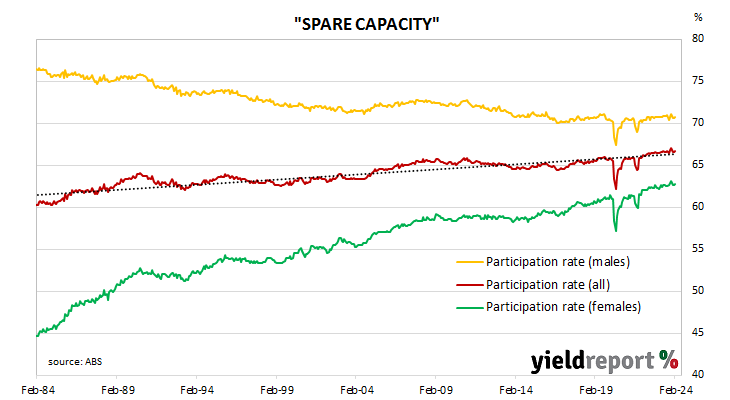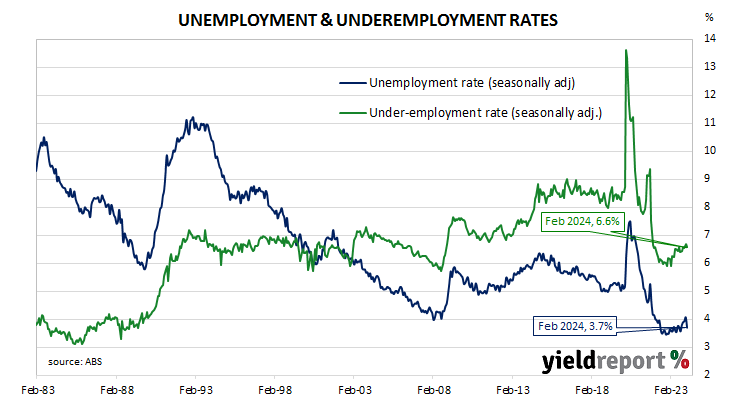Summary: Employment up 116,500 in February, much more than expected; ANZ: rebound was expected following weak December, January; ACGB yields rise; rate-cut expectations soften; MSA: labour market still very tight, loosening only gradually; participation rate ticks up to 66.7%; jobless rate drops from 4.1% to 3.7%; more part-time jobs, more full-time jobs; aggregate work hours up 0.8%; underemployment rate ticks down to 6.6%.
Australia’s period of falling unemployment came to an end in early 2019 when the jobless rate hit a low of 4.9%. It then averaged around 5.2% through to March 2020, bouncing around in a range from 5.1% to 5.3%. Leading indicators such as ANZ-Indeed’s Job Ads survey and NAB’s capacity utilisation estimate suggested the unemployment rate would rise in the June 2020 quarter and it did so, sharply. The jobless rate peaked in July 2020 but fell below 7% a month later and then trended lower through 2021 and 2022.
The latest Labour force figures have now been released and they indicate the number of people employed in Australia according to ABS definitions increased by 116,500 in February. The result was much more than the 40,000 increase which had been generally expected and in contrast with January’s downwardly-revised loss of 46,500.
“The outcome was stronger than expected but in line with expectations of a rebound following weak December and January outcomes and elevated numbers of people waiting to start work,” said ANZ senior economist Blair Chapman. “The Australian Bureau of Statistics noted that the larger than usual number of people waiting to start work in December and January contributed to the large employment increase in February. In addition, fewer people left employment between January and February than is typical.”
Domestic Treasury bond yields rose across the curve on the day. By the close of business, the 3-year ACGB yield had gained 5bps to 3.66%, the 10-year yield had added 4bps to 4.11% while the 20-year yield finished 6bps higher at 4.44%.
In the cash futures market, expectations regarding rate cuts over the next 12 months softened. At the end of the day, contracts implied the cash rate would remain close to the current rate for the next few months and average 4.315% through April, 4.295% in May and 4.275% in June. However, August contracts implied a 4.17% average cash rate, November contracts implied 4.005%, while February contract implied 3.865%, 46bps less than the current rate.
“After this print, labour force data are now more consistent with what the suite of labour demand indicators are suggesting, in our view,” said Morgan Stanley Australia economist Chris Read. “That is, the labour market is still very tight and is loosening only gradually. Strong migration flows continue to support the strong jobs numbers, but do not look to be assisting spare capacity in a meaningful way.”
The participation rate ticked up from January’s revised figure of 66.6% to 66.7% as the total available workforce increased by 64,600 to 14.818 million while the number of unemployed persons decreased by 51,900 to 548,300. As a result, the unemployment rate dropped from 4.1% to 3.7%.
The aggregate number of hours worked across the Australian economy rose by 0.8% as 38,300 residents gained part-time positions and 78,200 residents gained full-time positions. On a 12-month basis and after revisions, aggregate hours worked increased by 3.6% as 290,100 more people held part-time positions and 147,00 more people held full-time positions than in February 2023.
More attention has been paid to the underemployment rate in recent years, which is the number of people in work but who wish to work more hours than they do currently. February’s underemployment rate ticked down from January’s revised figure of 6.7% to 6.6%, 0.7 percentage points above this cycle’s low.
The underutilisation rate, that is the sum of the underemployment rate and the unemployment rate, has a strong correlation with the annual growth rate of the ABS private sector wage index when advanced by two quarters. February’s underutilisation rate of 10.3% corresponds with an annual growth rate of about 4.1%.




